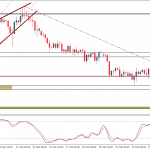Corporations have more than doubled their debt levels since 2008’s financial crisis, from $3.5 trillion to $8.1 trillion. They are carrying more leverage (e.g., debt-to-revenue, debt-to-EBITDA, etc.) than at any point since the 2000-2002 tech wreck. And the cash relative to the debt on corporate books has been dropping precipitously.

Granted, one can choose to emphasize the inexpensive nature of the credit.
Why shouldn’t companies borrow by the boatload as long as interest rates remain relative contained?
For one thing, corporate borrowing costs may not always remain as friendly as they are today. At least $1 trillion of the debt will come due within the next five years and the debt will need to be refinanced (a.k.a. “rolled over”) in the future when the borrowing may be more expensive. It follows that a much larger percentage of corporate revenue may wind up going toward interest payments.
Equally troubling, the Federal Reserve is demonstrating a determination to raise borrowing costs with a 0.25% hike at toda’ys March 15 meeting. Fed Chair Janet Yellen explained that removing ultra-accommodating rate policy “reflects the economy’s continued progress.” However, over the last few years, job growth has slowed from 2.5% to 1.4%. Gross domestic product (GDP) has been decelerating, with the Atlanta Fed’s model predicting expansion of just 0.9% in Q1. And retail sales in February haven’t been this dismal since last August.
Indeed, stocks rallied on Yellen’s portrayal of economic acceleration. But the bond market? Instead of yields climbing as many would have anticipated in a tightening phase, yields declined across the curve. Both the 5-year Treasury yield and the 10-year Treasury yield dropped nearly 10 basis points from 2.1% to 2.0% and from 2.6% to 2.5% respectively. Perhaps the bond market is not “buying” the Fed’s economic cheerfulness.
Third, if an economy is humming, shouldn’t corporate borrowers be increasing their income hand over fist? Instead, S&P 500 companies are growing debt at a double-digit clip (10%-plus), while struggling to produce significant revenue growth (4.2% year-over-year). Dow components have toiled to grow their sales over the last five years.














Leave A Comment